History
The Government School Run by Indian Agent Located on South Shore of Flathead Lake, 1906-1913
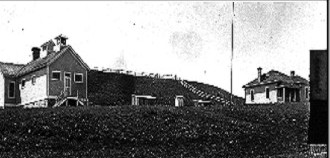
Polson Government School and Indian Agent's Home [Betty Hoskinson Brill Collection]
The Government School run by the Indian Agent and taught by Mr. W. G. Brown operated at least in 1906 and into the 1910's. According to Velma R. Kvale in Where The Buffalo Roamed, W. G. Brown and family were at a school north of where the old Ducharme School now stands on the south shore of Flathead Lake. He had taught for a year at the Government School in Ronan in 1906 and was sent to a new area the next year, probably the Polson Agency. Mr. Brown also taught the first school in the Polson area. He started a school there and remained for three years. The school was located behind the Agent's, or subagent's, home just east of the Joseph Dixon ranch (now the present McAlpin Ranch and originally Mrs. Polson's Indian Allotment) on the South shore of Flathead Lake.
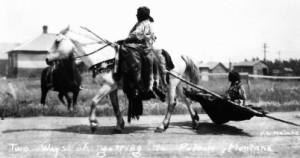
Julie Meiers labeled this "Two Ways of getting toPolson, Montana" about 1912 [Betty Brill Collection]
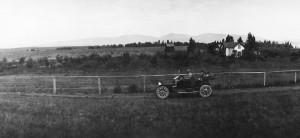
The Joseph Dixon Ranch built by David Polson with log cabin for his mother Mary. Julius & Marie Schmidt leasees driving car to Polson about 1912 [Betty Brill Collection]
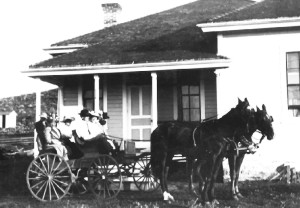
SubIndian Agent Jim Hoskinson, wife Emma, and Schmidt Family in 1912 [Betty Brill Collection]
In 1912 Emma Rakowiez lived with her grandparents/foster parents, Julius and Marie Schmidt, who leased the David Polson ranch bought by Joseph Dixon in 1916. Old Mrs. Polson lived in a log house beside the big house which David Polson built for his mother on her allotment. Next door the bachelor James "Jim" Hoskinson had come in June of 1909 to the Indian School East of town to serve as Sub Agent under Major Morgan. His job was to rent allotments to settlers and issue checks to the Indians. He also was to take food to the Indians up around Elmo and other places. Emma and Jim married in 1912 with Mrs. Polson attending. Hoskinson's moved into the Government house in front of the Government School. By 1913 the couple moved to the Jocko. So for a few years we know the Government School served the Indian children of the neighborhood. While the school closed down, the agency still operated in 1919 when Pat Shea was BIA Agent. (Emerald Barker corresponds with Mrs. Letha Morigeau Shea who lives in Otis Orchards, Washington. -- Sister is at St. Luke's in Ronan - Alma Morigeau Luedtke.)
Beginnings of Ducharme School
On July 9 of 1913 the taxpaying parents of children in the South Shore area petitioned Flathead County Superintendent May Trumper to create a Ducharme School District:
That there is no school house in the proposed new district and these petitioners respectfully ask that a new district be created so their children might attend school without having several miles to walk. Wherefore, your petitioners pray that your Honor look into the facts and the foregoing situation and do that which your Honor deems best, both for the good of the children and the community in which they live.
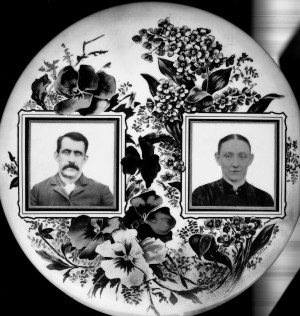
Ben and Caroline Ducharme before 1900 [Plate is from Emerald Bonser Barker Collection]
Fourteen petitioners signed and listed 36 names of children of school age residing in the proposed new district. Legible names of Petitioners included: Alex Beauvais, Frank Ducharme, Jr., Ben Ducharme, Caville Dupuis, R. -- Lowe, J. J. ------, A. Bruckmann, Mr. Arcason, Joseph Kinnele, Mitch Michell, A. R. Ha---back, Alden ----, -------, -------. Legible names of the children listed in Exhibit A included: Clary Beauvais, Margaret May Beauvais, Bazil Ducharme, Arthur Marengo, Florence Ducharme, Edmund Dupuis, Willie A. Dupuis, Robert R. Dupuis, Alice P. Dupuis, Peter O. Dupuis, J. Olivia Dupuis, Mary Lowe, Oda Lowe, John Lowe, Henry Bruckmann, Mary Bruckmann, Joseph Bruckmann, Anna Bruckmann, Nora Bruckmann, Myrtle Dupuis, ---, Hazel ---- , Martha Kinnele, Jacob ----, ---, -----, -----, -----, Willard Roland "Hub" Dupuis, --- Dupuis, Morton Dupuis, Elmer Cook, Mable Cook, Cammile Cook, Victoria Bell (Burland), Frank Thomas Bell (Burland), Alice Maynard and Norma Maynard. Petition not granted for the reason that the valuation of $10,000 so required by law can not be raised in the district. Signed// May Trumper Co. Supt. Schools
The area thus remained a part of District No. 23 -- Polson until March 18, 1998 when it was returned to the heirs of Ben and Lucy Ducharme.
Benjamin Ducharme Donates An Acre of His Allotment for School
By October of 1913 Benjamin Ducharme, through the writing of First Agent Karl Knudsen, requested to set aside one acre of his fee patent [AO #154] for a school for the children of the area. Ben could write his name but otherwise was uneducated, or illiterate, having had only one year of education. But he had a genuine concern that his daughters and the other children of the neighborhood would receive an education. He wanted to give the school trustees the land for a school "to help the growing generation." The process for application through the government acting as caretaker to the Indian people of the reservation was complex with pages of questions asked. Some questions were demeaning and/or condescending such as:
Is he addicted to the use of intoxicants? To which Karl Knudsen types: Is not addicted to its use. States he takes a drink when he can get it. As to whether the statements made in the application were correct, Agent Knudsen answers: Applicant is industrious and self-supporting. Is not in debt. In my opinion the answers made by the applicant to the questions contained in his petition is correct.
In 1913 Benjamin Ducharme thus donated one acre of land for the Ducharme School. The legal description dated April 20, 1915 was:
Beginning at the southwest corner of Section 5, thence east 208.71 feet; thence north 208.71 feet; thence west 208.71 feet; thence south 208.71 feet to the point of beginning in Township 22 N, Range 19 W, Montana Meridian, containing one acre.
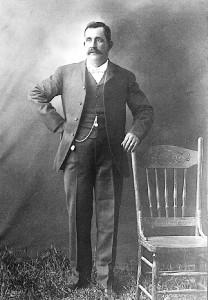
Benjamin Ducharme [Emerald Barker Collection]
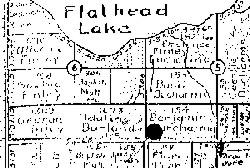
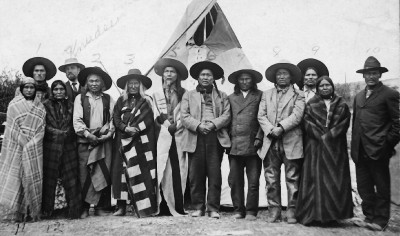
Flathead Indian Agent Karl Knudsen with Tribal Leaders L to R Mary Antiste, 1 John Couture, Mary's Mother, Agent Knudsen, 2 Chief of Kutenai (Antiste), 3 Chief of Flathead Kakishee, 5 Blind Frank Michell, 6 Charles Michell, 7--Moses, 8 Martin Charlo? Koostatah, 9 Mascilla Michelle, Koostatah's wife, 10 John Naguare Finley [Betty Brill Collection]
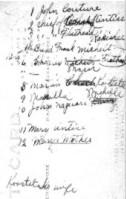
Names written on back of picture
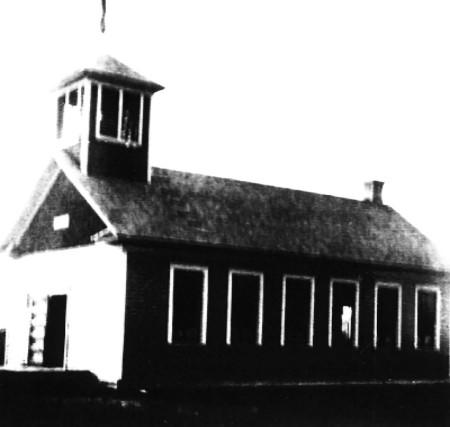
Ducharme School
School at Ducharme from 1913 to 1927
Mildred McCullough taught the 1913-14 school year for $60 a month. The next year Carmelita Barnes taught 43 enrolled students at the same salary. Stella Stonehocker Parker wrote to the historians:
When I was eight years old our family moved from North Dakota. My dad's parents and our family, my grandparents rented the old Polson place (now the McAlpin place). Old Mrs. Polson still lived there in a little log cabin, being given permission to live there as long as she lived. My grandmother used to send me over with a pitcher of milk for her breakfast. While living there we, my uncle just a couple years older than I and my brother and sister, attended the Ducharme school for a short while, it was in 1914, before going to the Polson school for a while. We were staying with my aunt and uncle in Grandview until we rented a farm in Pablo where we went to school in 1923.
The Register Summary of Flathead County for Ducharme School in District No. 23 for September 8, 1914 to May 21, 1915 shows Carmelita Barnes as teacher to grades one through eight with 43 students: Harold, Floyd, and Wallace Anderson; Albert Archer, Frank and Victoria Bell, Joe, Nora, Mary, and Annie Bruckman; Homer Courville, Bessie daughter of Frank Ducharme, Florence daughter of Ben Ducharme, Roland, Eugene, and Merton Dupuis, sons of Alec Hardwich; Edmund, Willie, Peter, Robert, Alice, Agnes, Aline Dupuis, children of Caville Dupuis; Mertle Dupuis, daughter of Agnes Al(r)cosa; Helen Finley, Edward Hardwick, Adeline Harriet, Martha Kiemela, Mary and Oda Lowe, Ruth Madison, Archers and Herbert Maringo, Alice and Norma Maynard, Wesley and Clarence Roehr, Eugene, Stella, Zilla, and Adda Stonehocker children of Lon; Harry Stonehocker son of Simon; and Lokadio Zeretzke. We learn more of Lokadia's history from her obituary in the Missoulian, January 20, 1998 and from country school historian, Emerald Bonser Barker.
In 1910 when the Flathead Reservation opened up, Lokadia Zeretzke (later Dotz) moved with her parents to a homestead west of Ronan. She attended two one-room schoolhouses on the reservation, one at Mud Creek and the other, Ducharme School, east of Polson. In the 1930's Lokadia returned to the Round Butte homestead. The ties to the Ducharme area must have remained strong. While Dotz's were in Round Butte, Harry Bonser (husband to Ben Ducharme's daughter Cecilia) taught Leona Dotz Devine, Lokadia's daughter, piano lessons. Cecilia T. Ducharme married Harry H. Bonser on September 10, 1914 in St. Francis Church in Missoula. After a short period in Tennessee they lived in Polson where they began to raise their family -- two children and another one on the way when Harry served as a Marine in World War I. When the war was over another girl, Emerald (Barker) was born to them. In 1917 Bonser's moved to the east shore of Flathead Lake on Cecilia's Indian Allotment and built a large house and bought a few milking cows. Two of their daughters attended the Ducharme School on the land donated by their grandfather. Emerald went to the Ursuline convent her first five years and when the family moved into Polson, where Harry worked as Lake County Road Supervisor, she attended school in Polson. Harry Bonser played the slide trombone in the Polson Cowboy Band which often played Sunday nights on the yard of the courthouse before it was built.
Other settlers, Richard and Letta Lowe moved to the Flathead Reservation in 1910 coming to Ravalli on the Allard stage and homesteaded in the Mountain View area. Eight children were born to Letta and Dick: Oda (Depner), Mary (Wright), Velma (Lund), Eva (Read), John, Burdette, Leland and Margaret (Kelly). In addition to fine gardening on the dry land homestead, Leta served as a midwife to the local women and helped nurse many through the flu epidemic of 1917. She also loved to dance and play the piano at the many country dances often held in the schools. Later she would divorce Dick and married Otis Sandage moving to raise her family at his Mountain View homestead. Some of the children started school at Ducharme and later attended Mountain View. Daughter Mary shares this story of those early years:
Oda and I [Mary Lowe Wright] attended Ducharme school. We were the only white children among the Indian children who attended-a fact that did not enter the minds of any of us. We were used to having groups of two or three families of Indians go through our homestead. None of the homesteads were fenced. They would stop and ask us for water or flour and would bring in a container to be filled. They would also ask to put their horses out in our hay field. We kids thought it was great when anyone came. It was not long after the kids came to Lake County in 1910 that a lot of settlers came into the area-mostly of German descent. About the same time, many of the Indians disappeared.
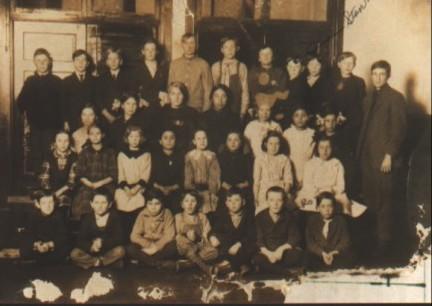
Ducharme Students 1915 Stan Thurston 4th from right in top row, Roy Thurston bottom row 2nd from right [From both the Lois Houle and Stan Thurston Collections]
The flu epidemic came and there weren't enough well people to bury the dead. The school was closed. Old Dr. Powell from Ronan drove his horse and buggy all over the countryside to care for the sick.
In 1916 Cold weather set in as the February 10 Flathead Courier indicates 468 1/2 absences were reported from Ducharme due to cold weather. (Was this the flu epidemic referred to above with perhaps a wrong year?)
The Flathead Courier of January 2, 1917 show "Several of the patrons of the Ducharme School through their efforts have presented the school with a fine new book case." And the next month: There will be a big dance at the Ducharme School house Saturday, February 10. Everybody is invited. In 1917 there are only 11 students that are taught by Lydia Smith.
Frank "Wilbur" Ducharme was born August 21, 1910, in St. Ignatius, to Frank and Emerence Ducharme. He received his education at the Ursuline Academy in St. Ignatius, the Ducharme schoolhouse and at Chemewa Indian School in Oregon.
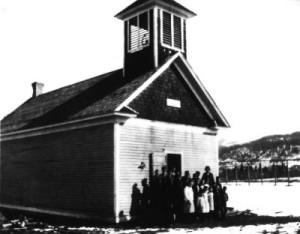
Ducharme School 1920, Helen Findley Teacher [Jane Bratton Burley Collection]
Winifred Daley began teaching the 1918-1919 school year to be replaced by Helen L. Findley. Some of the 36 students were: Fred Gloves Jr., Eleanor and Eileen Jensen, Tub Anderson, May, Herb, and John Holmes, Harry Munce, John Turner, Sally Savage, Alice Coomb, and Don Dunn.
Enrollment rose to 52 student, 32 boys and 22 girls, in 1919-1920 when Helen Findley again taught.
Other students remembered from those years include: George, Bubber, and Wilber Ducharme, William Shrider, Theresa and Ethel Bonser.
The School Board and Polson area community very generously invited all teachers in the system to "a good old Western Montana "barbeque" and trail blazin shindig given by Co9l. A. A. White of Polson in honor of the newly arrived school ma'ams to this end of Flathead Gulch." The invitation letter dated October 29, 1919 was addressed to "Dear Tenderfoot:" and signed "Cordially yours, James Harbert, President School Board.
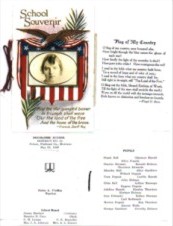
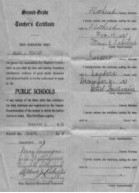
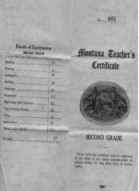
The Bratton Story in IN THE SHADOWS OF THE MISSIONS tells that Helen Findley's father Joe heard glowing stories about Montana, especially about Polson, so he sold out their Iowa place and loaded his family and stock onto an emigrant train headed for Kalispell arriving in December 1911. The bad winter prevented them from heading for Polson until March when they still had a treacherous trip over icy Angel Hill. The family moved into cabins near the Grandview until finding land on the southside of Irvine Flats. Helen rode horseback to a log cabin school and finally moved into Polson in 1914 so she could attend Polson High School. She graduated and went to teacher's college at Dillon. She got the teaching job at Ducharme in 1918-1919 for $90 a month "because it was a tough school. Helen had a lot of experience, but she stuck it out." Helen married Neil Bratton in 1920 at Missoula in the Methodist parsonage. They lived in Hot Springs where she taught another year, finally moving to Round Butte during the worst of the depression in 1930. The Brattons had six children, all attended the Round Butte and Ronan schools. Daughter Jane Bratton Burley submitted the program and picture from Helen's teaching souvenirs. Helen Findley Bratton died in 1981.
Some students remembered from the 1921-22 class of Mrs. Mae Dyer who had 19 boys and 10 girls are: A. L. (Bud), Albert, Henry, and May Beauvais, Vernon Glover, and Viola Moss (later Mrs. Roy Burton).
As a thirteen-year old boy, Francis Stinger was among the 1923 Ducharme students.
The Last Years at Ducharme
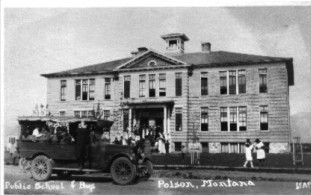
The Ducharme & Mountain View Bus to Polson
[Emerald Bonser Parker Collection]
By 1925-26 twenty-eight students were taught by Marcia C. Jackson for $900 a year salary. Marcia is again listed as teaching in 1926-27 and thereafter no teachers are listed for Ducharme School. Elwin Bennington said he missed going to the school by one year as his family moved to the South Shore area in 1926. He knows that his father Lewis L. Bennington was amongst the petitioners to close the Ducharme School. Children were bussed to Polson. At the August 15, 1926 meeting, the Trustees of Polson School District No 23 moved to advertise for transportation bids for the children from Mountain View and Ducharme to be bussed into Polson starting September 3. Also in 1926 Mae Valk (McIntire) came from Butte to teach the first grade at the Lincoln School. At that time, her class was on the upper east end of the school. The other end of the second floor of the school served as the Court House. The first two school buses, homemade except for the working parts of the trucks, brought the children to town schools from the Ducharme and Mountain View areas. One door at the back of the bus was entry and exit for the kids. Stan Thurston's father drove the Yellow Bay-Finley Point Route from 1930 to 1958. His first contract was for $130 and he paid $115 for the Ford bus.
Ben Ducharme, who donated his allotment for the school, died in 1932. After Ben's death and the school was already closed, widow Lucy was given the right to live in the schoolhouse, tax free, her life-time. There she made her home until her death in the 1980's from the infirmities of old age with family beside her.
The Ducharme donation sparked a land controversy not entirely settled today. From the Ducharme heirs and from a May 6, 1983 letter from Tribal Council Chairman Thomas E. Pablo to Polson District Superintendent Dr. Lee Christiansen, we learn the original deed Ben had the Agent make up contained a reversionary clause in it that stated: "That should the land herein described failed to be used for school purposes or abandoned, it shall revert to the original owner." The story goes that there was an error in the land description and Mr. Ducharme would not sign until it was corrected. When the description was corrected the reversionary clause was omitted. Unfortunately, the signed deed only provided that the privilege of attending schools on the land would not be denied children of Indian blood. The injustice was not remedied until 1996 when a Mr. Mitchell attempted to purchase the property from the Polson School to insure his easement to his home that was already procured. Trustee Steve Lozar made a motion to Quitclaim the Ducharme property to the heirs of Ben and Lucy Ducharme, honoring any prior easements established. Nancy Lindsey seconded the motion and the motion carried unanimously. [From Regular Board Meeting Minutes of October 14, 1996] So the abandoned school property was held by Polson School District No. 23 until 1996 when it was returned to the 54 heirs as listed in the warranty deed recorded March 5, 1998.
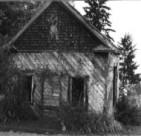
Confederated Salish & Kootenai Tribal Preservation Office, October 1999

1999 Ducharme remains [Jane Burley Collection]
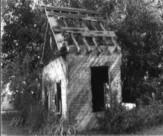
Cultural Resource Inventory for Montana Highway 35 Project
In 1998, the deteriorating school building on Highway 35 was torn down leaving only a front.
Clarence W. Roehr, a retired Seattle surgeon, was born in 1906 in Oklahoma Territory. At two years old his parents and older brother Wesley and he moved to the Flathead. The boys were Ducharme students in 1914. He shared that long ago experience attending Ducharme:
The one room school house maybe, I should have made that a three room school, as there were two bathrooms, male and female. We walked the mile or so to and from school and carried our lunch. The school room had a big heater that burned wood. The Flathead Indians were the tribe that populated the Flathead reservation. The students were quite amenable to the teacher. I can't think of any particular school news to write to you that would be of interest, except that being in a one room school made us compete with the upper grades to see who could be smarter than the upper class men, so it was good mental exercise.
